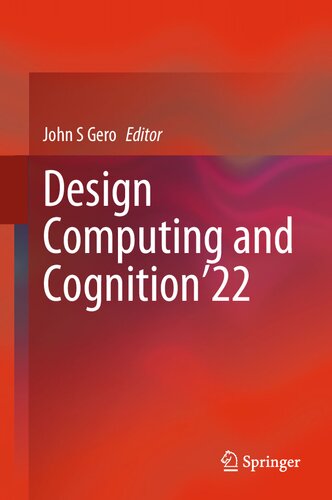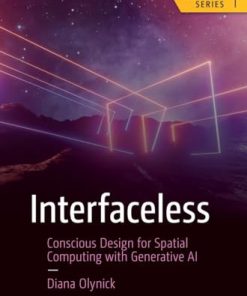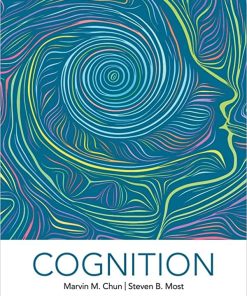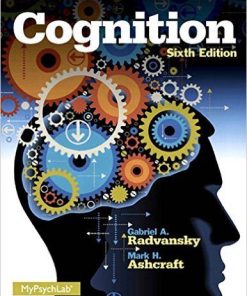Design Computing and Cognition’22 1st Edition
$50.00 Original price was: $50.00.$25.00Current price is: $25.00.
Design Computing and Cognition’22 1st Edition – Ebook Instant Download/Delivery ISBN(s): 9783031204173,3031204174,9783031204180, 3031204182
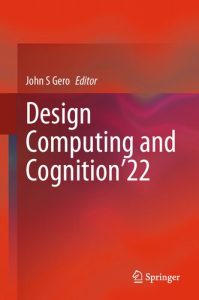
Product details:
- ISBN-10: 3031204182
- ISBN-13: 9783031204180
- Author: John S. Gero
This book reports research and development that represent the state of the art in artificial intelligence in design, design cognition, design neurocognition, and design theories from the Tenth International Conference on Design Computing and Cognition held in Glasgow, UK, in 2022. The 48 chapters are grouped under the headings of natural language processing and design; design cognition; design neurocognition; learning and design; creative design and co-design; shape grammars; quantum computing; and human behavior. These contributions are of particular interest to design researchers and design educators, as well as to users of advanced computation and cognitive science. This book contains knowledge about the cognitive and neurocognitive behavior of designers, which is valuable to those who need to gain a better understanding of designing.
Table contents:
- Natural Language Processing and Design
- Extracting Information for Creating SAPPhIRE Model of Causality from Natural Language Descriptions
- Recognizing the Structure of Biological Designs in Text Documents
- Generative Design Ideation: A Natural Language Generation Approach
- The ABC (Affordance-Bias-Cognition) Reasoning of Product-Use Interaction: A Text Mining Approach
- Design Progress Dashboard: Visualising a Quantitative Divergent/Convergent Pattern of Design Team Progress Through Natural Language Processing
- TechNet 2.0: Expanding Technology Semantic Network with Qualitative Relations to Enhance Reasoning Capabilities
- Design Cognition—1
- A Classification of Methods and Constructs in Design Cognition Research
- Is the PSVT:R Suitable for Evaluating Spatial Skill in Design? A Critique
- Effects of Open-Endedness on Problem Solving Behaviour
- A Focussed Literature Review of Dual-Process Thinking to Inform the Study of Hackathons
- A Systems Thinking Inspired Approach to Understanding Design Activity
- Investigating the Cognitive Processes Involved in Design Ideation Using Psychological Tests
- Design Neurocognition
- Brain and Behavior in Engineering Design: An Exploratory Study on Using Concept Mapping
- EEG Microstate Characteristics in Product Conceptual Design: Increased Time Coverage of Microstate Class Related to the Default Mode Network
- Neurophysiological Responses to Biophilic Design: A Pilot Experiment Using VR and EEG
- Comparing Designers’ EEG Activity Characteristics for Common Association and Remote Association
- Characterization of Design Brain States Over Time When Using Morphological Analysis and TRIZ
- Learning and Design
- Representing Design Cognition Through 3-D Deep Generative Models
- Classifying Building and Ground Relationships Using Unsupervised Graph-Level Representation Learning
- Data-Based Generation of Residential Floorplans Using Neural Networks
- Voxel Substitutional Sampling: Generative Machine Learning for Architectural Design
- Creative Design and Co-design
- The ‘Atlas’ of Design Conceptual Space: A Design Thinking Framework with Cognitive and Computational Footings
- Computer Games for Design Creativity Research: Opportunities and Challenges
- Exploring Designers’ Encounters with Unexpected Inspirational Stimuli
- Collaborative Design: Evolution of Project’s Information and Role of the Graphic Interactions
- Collaborative-Knowledge Construction Activity Method to Analyse Design-Learning in VR Co-design Crits
- Revisiting Darke: Tracing the Emergence of Design Generators in Architectural Design
- Design Cognition—2
- Inspirational Stimuli Attain Visual Allocation: Examining Design Ideation with Eye-Tracking
- Using Eye Tracking to Measure Cognitive Load of Designers in Situ
- A Test of the Structural Alignment Model for Similarity Judgements of Design Concepts
- Design Strategies that Work: How Engineers Use Sequential Decision-Making to Improve Design Performance in Concept Selection
- Knowledge Transfer in Designing as a Situated Activity: A Case Study of Spatial Design Using Lego Blocks
- Shape Grammars and Design Knowledge
- Back to the Drawing Board: Shape Calculations in Shape Machine
- Notes on Shape Valued Functions
- Making Grammars for Computational Lacemaking
- An Agent-Based Approach to Adaptive Design Based on Influences Mediated by Artifacts
- Visualization of Design Data in the Wild: Interactive Evaluation and Exploration of Combined Performance and Geometric Data
- Dimensions of Prototyping Knowledge: Characterising Prototype Evaluation Methods and Their Contributions to Design Knowledge
- Design Generation and Quantum Computing
- A New Approach to Facilitated Idea Generation and Application Through a Preliminary Study
- The Impact of Procedural Knowledge Retrieval on the Architectural Design Process in Parametric Design Environments
- Evolutionary Optimization of Benchmarks: Parametric Typologies for Generating Typical Designs
- Imager, Interpreter, Aesthete: Roles Played by Design Students in Graphic Design Ideation
- Research Questions in Applying Quantum Computing to Systems Design
- Human Behavior
- “Like a Moodboard, But More Interactive”: The Role of Expertise in Designers’ Mental Models and Speculations on an Intelligent Design Assistant
- How Long Until We Are (Psychologically) Safe? A Longitudinal Investigation of Psychological Safety in Virtual Engineering Design Teams in Education
- The Effect of Design Styles and Logos on Product Preference
- How Does Machine Advice Influence Design Choice? The Effect of Error on Design Decision Making
- The Creation of Emotionally Attuned Patterns Through an Analysis of Line
People also search:
design computing and cognition 2022
design computing and cognition
design computation
design computation mit
cognitive design
digital design and computer architecture (2nd edition)
You may also like…
Computers - Artificial Intelligence (AI)
Business & Economics - E-Commerce
Psychology
Computers - Computer Science
Politics & Philosophy - Ancient & Medieval Philosophy
Computers - Hardware
Chiplet Design and Heterogeneous Integration Packaging 2023rd Edition
Engineering - Mechanical Engineering & Dynamics
Theory and Design for Mechanical Measurements 7th Edition Richard S. Figliola
Psychology


